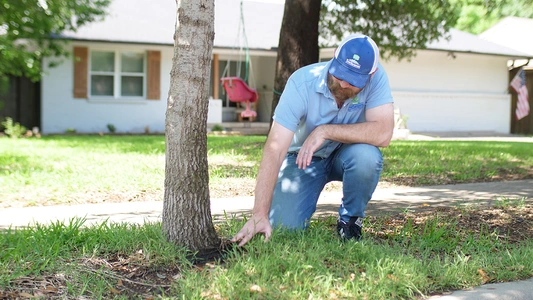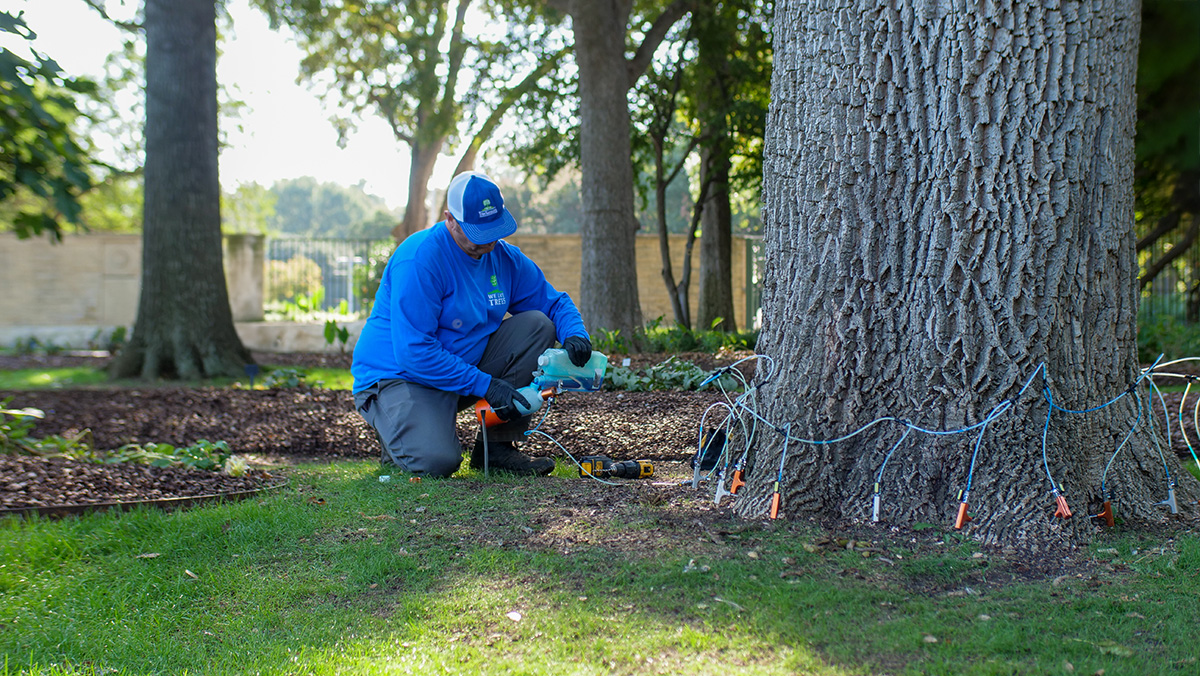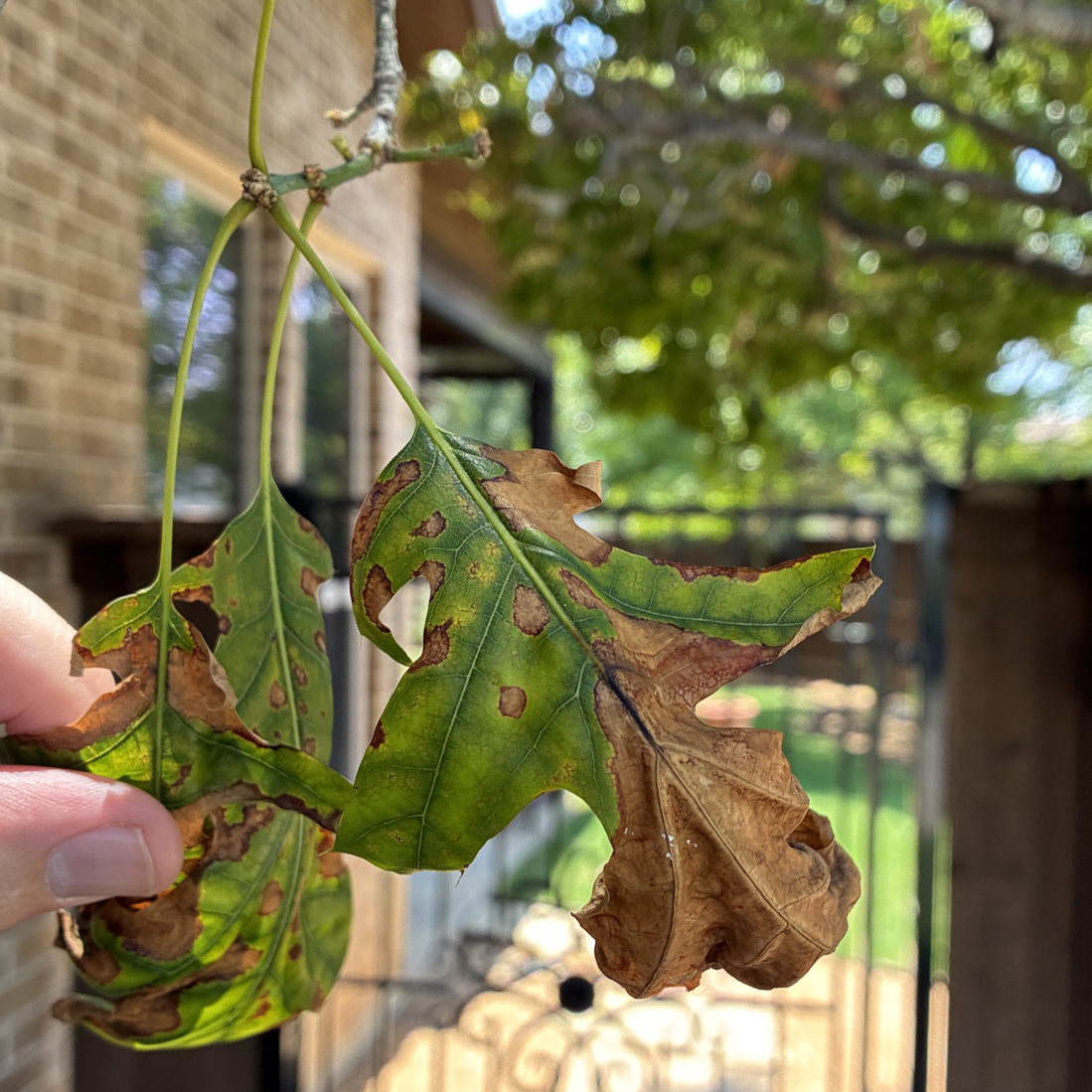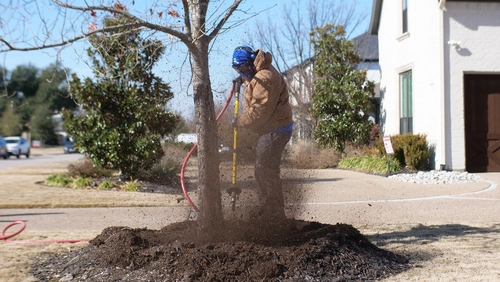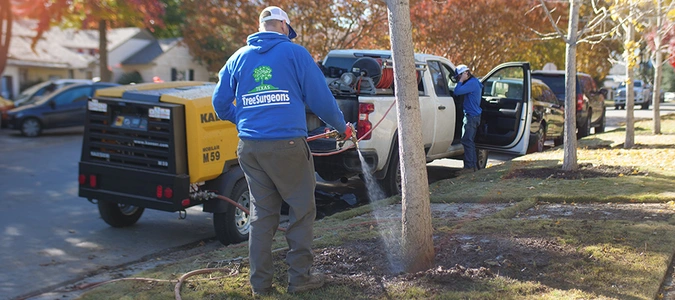
Tree Health Care
We are rooting for trees!
Tree Health Care, also known as Plant Health Care is similar to health care provided to humans and other living things. Trees are living organisms and can get a weakened immune system similarly as an animal or plant would.
When we use the term Tree Health Care it is a word that encompasses all aspects that help keep a tree healthy by managing disease and insects in sick trees; fertilization*, insect control, disease identification, and disease managements.
*Fertilization is a term most arborists and Tree Health Care / Plant Health Care technicians don’t like. What we do is soil amendments. Rather than dumping an onetime “vitamin” on a tree that only has short term effects, changing the soil structure and giving the tree access to what it needs is the best practice.
Why would a tree need Tree Health Care?
Unlike trees in a forest urban trees do not have the protection of other trees surrounding them like they would in a forest. A single tree planted in a yard does not have the same nutrient rich soil from a layer of decomposing leaf debris. Urban trees live in warmer soil conditions due to concrete and typically being singular.
Trees in an urban environment are more stressed and are more prone to health problems because of several environmental factors. Trees in North Texas have region specific issues and patterns of health problems.
Having an ISA Certified Arborist who understands the complex ways soil and tree species determine specific needs and care of your tree will ensure the long term health of your tree.
Need a local ISA Certified arborist whose tree health care application changes based on tree needs and micro environment? Please contact us for a free visit.

Mushrooms at the Base
learn more
Lack of Growth
learn moreCommon Tree Problems
Diseases, insects, and health problems to look out for

Yellow Leaves
learn more
Root Disruption
learn more
Increased Ground Temperature
learn more
Competing Root Systems
learn more
Ask yourself these questions prior to hiring:
- Do they use one treatment for all
- Is the person using science based treatment
- Do they have a TDA license
- Are you getting advice from an ISA Certified Arborist
- Can they tell you where they are getting chemicals from
- Are they able to tell you what they are treating with and why
- Do they keep an ongoing record of how the tree has been treated in the past
Tree Health Care
View Photos of our ISA Certified Arborists & Tree Health Care Technicians Providing Consultation and Care

PREVENTATIVE EAB TREATMENT
If there is EAB activity within a few miles of where you live or property you manage we recommend preventative systemic insecticide treatment applied by a licensed TDA tree health care technician. EAB treatment lasts for 2 years and must be applied regularly to protect ash trees from infection.

OAK WILT TREATMENT
As oak wilt is a systemic, vascular disease, the most effective treatments consist of injecting the infected trees with a fungicidal chemical. The only currently recommended fungicide is Alamo®, a formulation of the fungicide propiconazole. The fungicide is administered through holes drilled in the root flare of the infected tree and should only be applied by Texas Department of Agriculture Licensed Applicators.

STRESSED MAGNOLIA | AFTER
This after photo was taken June 27, 2024 of a magnolia tree after receiving multiple interventions to improve its health. In addition to a tree health care plan of a deep root fertilization with Biopack plus and Sea3 applied by our TDA licensed technician the owner also fixed the irrigation and cleared the root flare. The difference in health is beautiful.

FERTILIZATION
Our Tree Health Care Programs are designed to deliver the right nutrients at the right times throughout the year. We use the highest quality soil conditioners and fertilizers that are delivered at critical points throughout the seasons to optimize the growth and health of trees.

DEEP ROOT INJECTION SERVICES
At Texas Tree Surgeons our deep root injection services provides fertilization deep into the soil. Our unique mixtures combine macro- and micro-nutrients, root growth stimulators, soil conditioners, beneficial biotics (both mycorrhizal fungi and rhizobacteria), and organic materials to cultivate the optimum natural growth environment.

ROOT PRUNING POST AIR SPADING
To correct this improperly planted tree our Tree Health Care Technicians air spade to expose the root flare and to prune away girdling roots. You can learn more about how to properly plant a tree here.

GIRDLING ROOTS
This tree was planted too deep and has several girdling roots (roots that circle the tree and do no flare out) that left unmanaged would eventually kill the tree. After air spading our Tree Health Care Technicians are pruning the roots and adjusting the soil around the tree to expose the root flare to improve tree health.

INSPECTING FOR POSSIBLE DECAY
Sometimes issues with a tree aren't clearly visible on the outside so an arborist will need to inspect the interior. An arborist does this by probing with a small knife to see how extensive the decay in a region of a tree is. Arborists are able to use this information along with other signs to determine if there are potential structural issues or possible increased chances for failure.

MEASURING DBH
The best way to approximate the size of a tree is to measure their dbh, (diameter, breast, height). This enables our arborists to estimate the amount needed for Tree Health Care products or pricing for Tree Removal.
